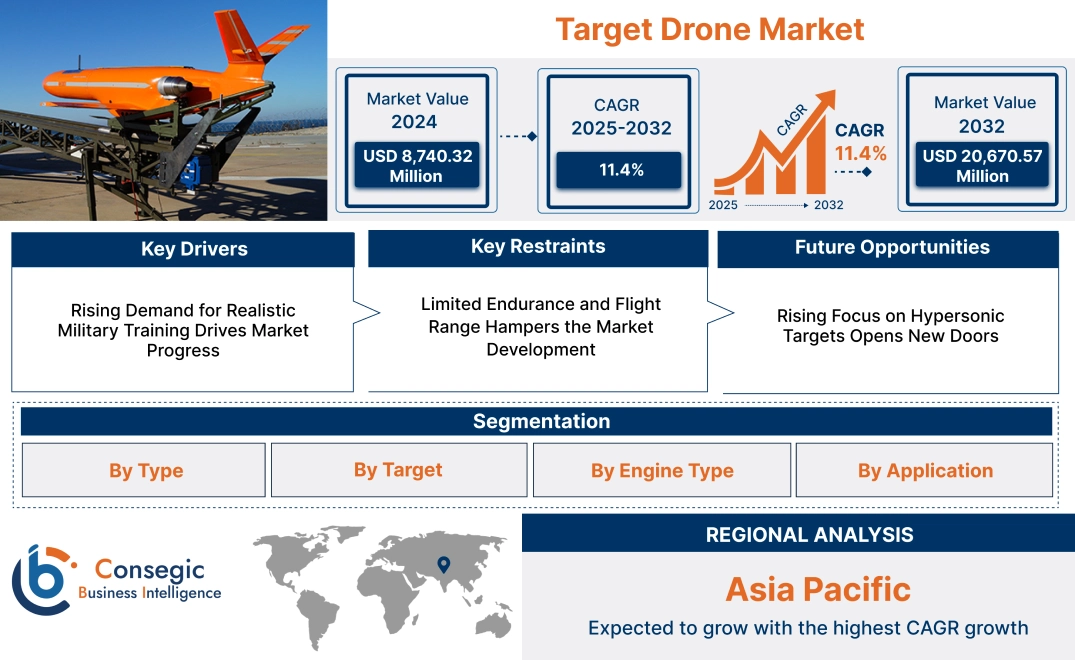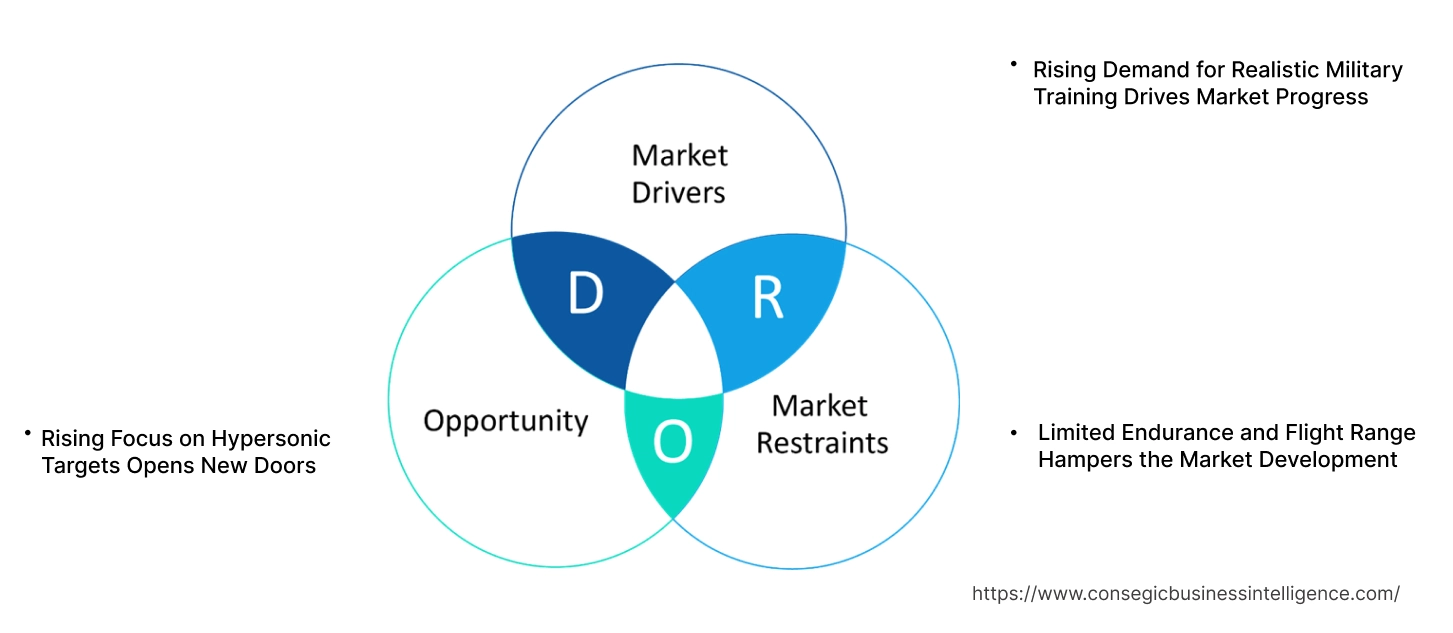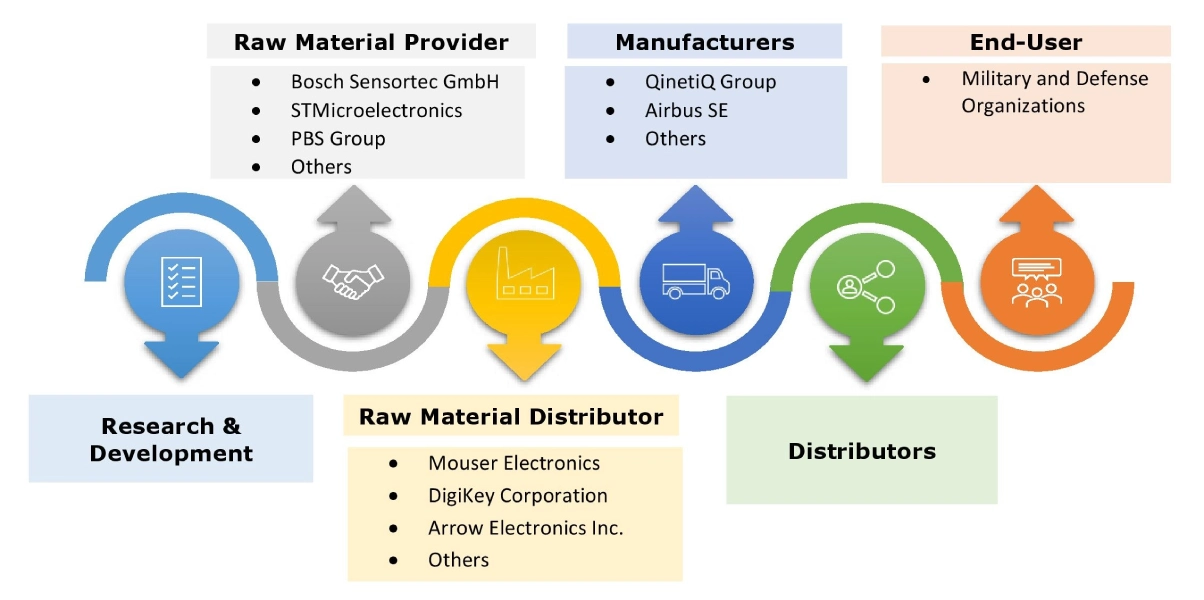Target Drone Market Size:
Target Drone Market size is estimated to reach over USD 20,670.57 Million by 2032 from a value of USD 8,740.32 Million in 2024 and is projected to grow by USD 9,577.48 Million in 2025, growing at a CAGR of 11.4% from 2025 to 2032.
Target Drone Market Scope & Overview:
Target drones refer to unmanned aerial vehicles (UAVs) that are designed to simulate various real-world threats for training military personnel and testing weapon systems. These drones act as aerial targets for anti-aircraft systems and other defensive weaponry, which helps in improving the skills of operators and evaluating the effectiveness of different systems. Moreover, the drones are primarily designed to simulate multiple aerial threats, including enemy aircraft, missiles, and other potential hazards, for military training and weapon testing. Additionally, modern target UAVs are often designed with advanced sensors and imaging technology for facilitating enhanced realism and can be remotely controlled or operate autonomously.
How is AI Transforming the Target Drone Market?
There is an emerging use of AI in the target drone market. AI integration helps in enhancing drone capabilities by facilitating autonomous operation, realistic behavioral simulation, and adaptive training scenarios. AI integration also allows target drones to learn, make real-time decisions, optimize flight paths, and even operate in swarms, in turn leading to more sophisticated defense simulations, effective military exercises, and improved cost-efficiency through predictive maintenance. In addition, AI enables drones to navigate complex environments autonomously, perform route optimization, and avoid obstacles in real-time. Further, drones can use AI to detect objects, process information, and make decisions during a mission with minimal human input, allowing them to adapt to dynamic combat scenarios. Thus, the above factors are anticipated to boost the market growth in upcoming years.
Key Drivers:
Rising adoption of advanced and live training in military & defense sector is propelling the target drone market growth
Target UAVs are widely used in the military and defense industry for live training exercises. They simulate enemy aircraft or missiles, which enables military personnel to practice targeting and engaging with various weapons systems in a realistic, yet controlled, environment. These drones are crucial for enhancing the readiness and effectiveness of air defense and other military units. Moreover, the drones provide a platform to test and evaluate the performance of new weapons systems and ammunition, ensuring they meet operational requirements. Additionally, the drones can be programmed with specific flight paths and maneuvers to mimic several types of threats, which makes military training more engaging and effective.
- For instance, the general budget for the European Defence Agency was valued at USD 54,095.5 million for 2024, witnessing an increase of 11% in comparison to USD 48,704.4 million in 2023.
Therefore, the growing military & defense sector is increasing the demand for advanced live training programs for preparing military & defense personnel for the complexities of modern combat and operational environments, in turn proliferating the target drone market size.
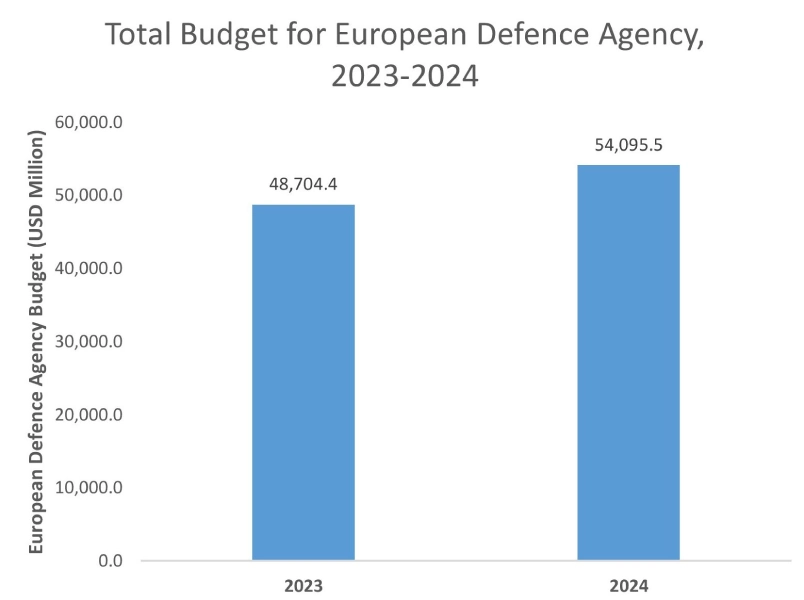
Key Restraints:
High initial investment and operational limitations are restraining the target drone market
The high initial investment associated with the development and deployment of these drones along with their operational limitations are among the primary factors restricting the market growth. The drones involve the utilization of advanced technologies, including sensors, control units, stealth capabilities, and others. The cost of procuring these systems and integrating them can be significantly high. Moreover, the additional costs associated with the drone’s operation and maintenance can limit its adoption, particularly among developing nations and military & defense organizations operating within strict budgetary limits.
Further, these drones are associated with certain operational limitations, including power source constraints, size and weight considerations, weather sensitivity, and complexities related to accurately replicating modern weapon systems. Consequently, the above factors are hindering the target drone market expansion.
Future Opportunities :
Increasing advancements associated with target drones are expected to drive the target drone market opportunities
Target UAVs play a crucial role in the military & defense industry to simulate various real-world threats for training military personnel and testing weapon systems. Hence, drone manufacturers are frequently investing in the development of new products and solutions with updated features to ensure their safe and effective utilization in military and defense sectors among others, which in turn is providing lucrative opportunities for market growth.
- For instance, QinetiQ offers cost-effective training target UAVs in its product offerings. The drone offers exceptional endurance and they are designed for threat representation and military operational training. The drones offer several features, including land and sea launching capability, more than 15 payload options in numerous configurations, and others.
Thus, according to the analysis, the rising advancements associated with target UAVs are expected to boost the target drone market opportunities during the forecast period.
Target Drone Market Segmental Analysis :
By Type:
Based on type, the market is segmented into fixed-wing target drones, rotary-wing target drones, and hybrid target drones.
Trends in the type:
- Increasing trend in utilization of fixed-wing drones, due to its higher speed capabilities, longer flight range, and greater payload capacity.
- Rising advancements associated with hybrid drones to provide extended flight times, versatile take-off and landing capabilities, and the ability to simulate various threat scenarios for military training are driving the market.
The fixed-wing target drones segment accounted for the largest revenue share of 51.30% in the total target drone market share in 2024.
- Fixed-wing drones are unmanned aerial vehicles with rigid wings, primarily used for training and testing of military weapon systems.
- They simulate threats for air-to-air and surface-to-air training, and can be used to test weapons such as missiles and cannons.
- Moreover, fixed-wing drones provide several benefits, including longer flight range and endurance, higher speed capabilities, improved stability in turbulent weather conditions, greater payload capacity, and relatively lower maintenance and operational costs, among others.
- For instance, Airbus offers fixed-wing airborne target UAVs in its defence product offerings, which are capable of simulating the complete engagement process from detection to action.
- According to the analysis, the aforementioned benefits of fixed-wing drones are further driving its adoption, in turn propelling the market.
The hybrid target drones segment is anticipated to register the fastest CAGR growth during the forecast period.
- Hybrid drones combine features of multi-rotor and fixed-wing drones, in turn offering extended flight times, versatile take-off and landing capabilities, and the ability to simulate various threat scenarios for military training.
- Hybrid drones are crucial for simulating realistic combat situations, which helps military personnel in improving their tactical skills and decision-making in a safe, controlled environment.
- Moreover, hybrid design enables longer mission durations as compared to traditional fixed-wing or rotor-based drones, in turn facilitating more comprehensive training exercises.
- Additionally, the ability to take off and land vertically, combined with the efficiency of fixed-wing flight, enables deployment of hybrid drones in various terrains and environments, even in areas with limited space.
- Hence, the aforementioned factors are anticipated to drive the adoption of hybrid drones, in turn propelling the market during the forecast period.
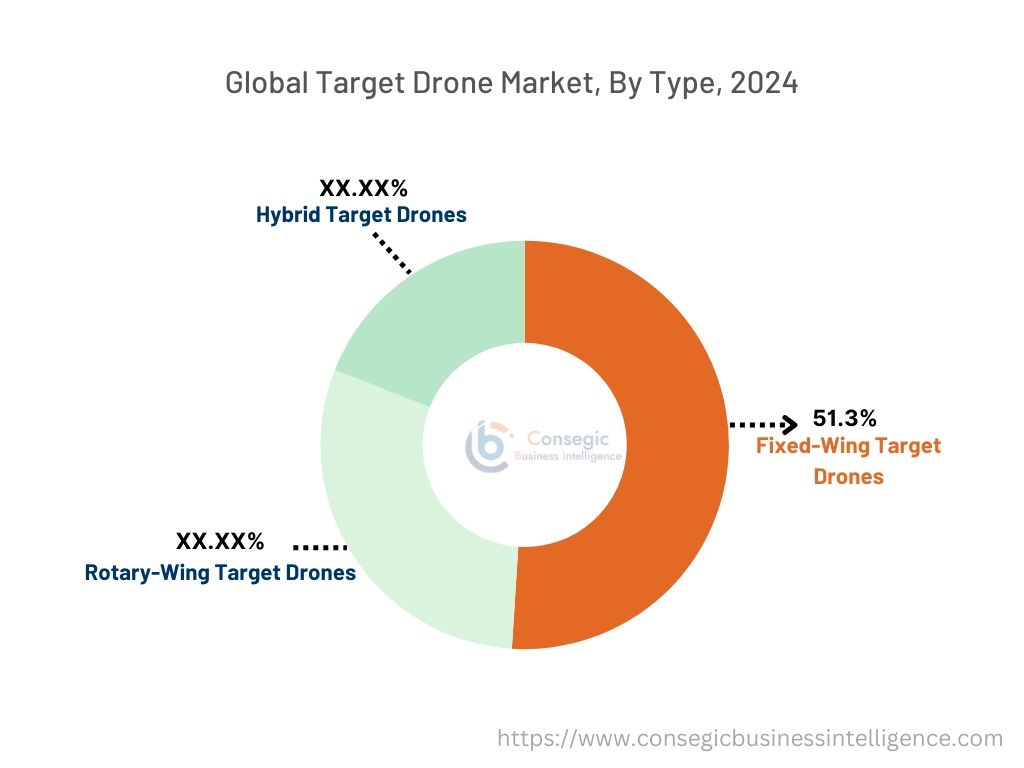
By Target:
Based on target, the market is segmented into aerial, ground, and marine.
Trends in the target:
- There is a rising trend towards the utilization of live training and simulation programs in military and defense organizations for training personnel in diverse environments, which is driving the market.
- Factors including significant expansion of naval fleets and rising maritime security concerns are among the key trends driving the growth of the marine segment.
Aerial segment accounted for the largest revenue in the overall target drone market share in 2024.
- Target UAVs are designed to simulate enemy aircraft or missiles, primarily for military training and testing purposes.
- Target UAVs offer a realistic aerial target for practicing live-fire exercises and enhancing the skills of anti-aircraft crews.
- They provide a moving target for practicing engagement with anti-aircraft systems, such as missiles, guns, and electronic warfare systems.
- Moreover, target UAVs can also be used to evaluate the performance of new weapon systems against realistic aerial threats.
- Consequently, the aforementioned factors are driving the target drone market trends.
The marine segment is anticipated to register the fastest CAGR during the forecast period.
- Target UAVs are often used in marine environments for naval training and testing of weapon systems.
- Target UAVs can simulate threats such as enemy vessels, which enables naval forces to practice engagement with missiles, torpedoes, and other weapons. This ensures that Navy forces can accurately engage moving targets at sea.
- Similarly, these drones can also be used for evaluating the performance of defense systems against various maritime threats.
- For instance, Airbus offers a complete range of target UAVs that offer realistic and cost-effective training for naval air defence, including naval targets, direct airborne targets, towed airborne targets, and surface targets.
- Thus, the above factors are anticipated to boost the target drone market growth during the forecast period.
By Engine Type:
Based on the engine type, the market is segmented into internal combustion engines, jet engines, turbojet engines, and others.
Trends in the engine type:
- Rising integration of internal combustion engines in target UAVs, due to its longer flight ranges, increased payload capacity, and extended mission endurance, among others.
- Factors including the rising need for high speed and maneuverability required in simulating missile threats and testing weapon systems, combined with compact power and rapid response capabilities, are among the key prospects driving the market.
The internal combustion engines segment accounted for the largest revenue share in the total market in 2024.
- Target UAVs typically utilize internal combustion engines for propulsion. These engines can range from two-stroke to four-stroke piston engines, and they offer a good power-to-weight ratio, which enables increased payload capacity, longer flight ranges, and extended mission endurance.
- Internal combustion engines enable target UAVs to fly longer distances and remain airborne for extended periods, which helps in facilitating more comprehensive training exercises.
- Moreover, the power provided by internal combustion engines enables the drones to carry various payloads, in turn enhancing the realism and effectiveness of the training.
- For instance, Sistemas de Control Remoto SL offers the MOAI target UAV, which includes an internal combustion engine that enables it to reach optimal speeds for conducting artillery firing exercises. The target UAV can tow sub-targets that are intended for military training of air defence systems.
- According to the analysis, the above factors are driving the target drone market size.
The turbojet engines segment is anticipated to register the fastest CAGR during the forecast period.
- Turbojet engines offer a good balance of power, thrust-to-weight ratio, and relatively compact design, which makes them suitable for use in target UAVs.
- Moreover, target UAVs often utilize turbojet engines, attributed to the growing demand for high speed and maneuverability required in simulating missile threats and testing weapon systems.
- Additionally, turbojet engines are capable of providing the required speed and altitude capabilities for realistic target simulation.
- For instance, PBS Group offers PBS TJ40 model of turbojet engine in its product offerings, which is specifically designed and manufactured for UAV systems, such as decoy drones, target UAVs, and small reconnaissance UAVs. Its key benefits include a low weight of 3.3 kg and a power thrust of 395 N.
- Therefore, the rising adoption of turbojet engines in target UAVs is anticipated to boost the segment growth during the forecast period.
By Application:
Based on application, the market is segmented into combat training, target acquisition, reconnaissance, and others.
Trends in the application:
- Rising adoption of target UAVs in military combat training applications involving the simulation of enemy threats, training anti-aircraft crews, testing weapon systems, and enhancing combat readiness is driving the market.
- Increasing trend in adoption of target UAVs in applications including target acquisition, intelligence gathering, border security, and aerial surveillance is projected to drive the market.
The combat training segment accounted for the largest revenue in the overall market in 2024, and it is anticipated to register a substantial CAGR during the forecast period.
- Target UAVs are primarily used in military combat training for simulating enemy aircraft or missiles, in turn providing realistic scenarios for practicing and testing defense systems.
- Moreover, these drones play an essential role in enhancing the accuracy and effectiveness of military personnel and weapon systems by allowing them to train against a broad range of simulated threats.
- Target UAVs are mainly used in military combat training applications involving the simulation of enemy threats, training anti-aircraft crews, testing weapon systems, and enhancing combat readiness, among others.
- For instance, QinetiQ offers target UAVs in its product offerings, which are specifically designed for use in military combat training applications. The company’s target UAVs are capable of simulating several advanced missile threats, which are designed for threat representation and military operational training.
- Consequently, the rising adoption of target UAVs in the military & defense sector for combat training applications is driving the market.
Regional Analysis:
The regions covered are North America, Europe, Asia Pacific, the Middle East and Africa, and Latin America.
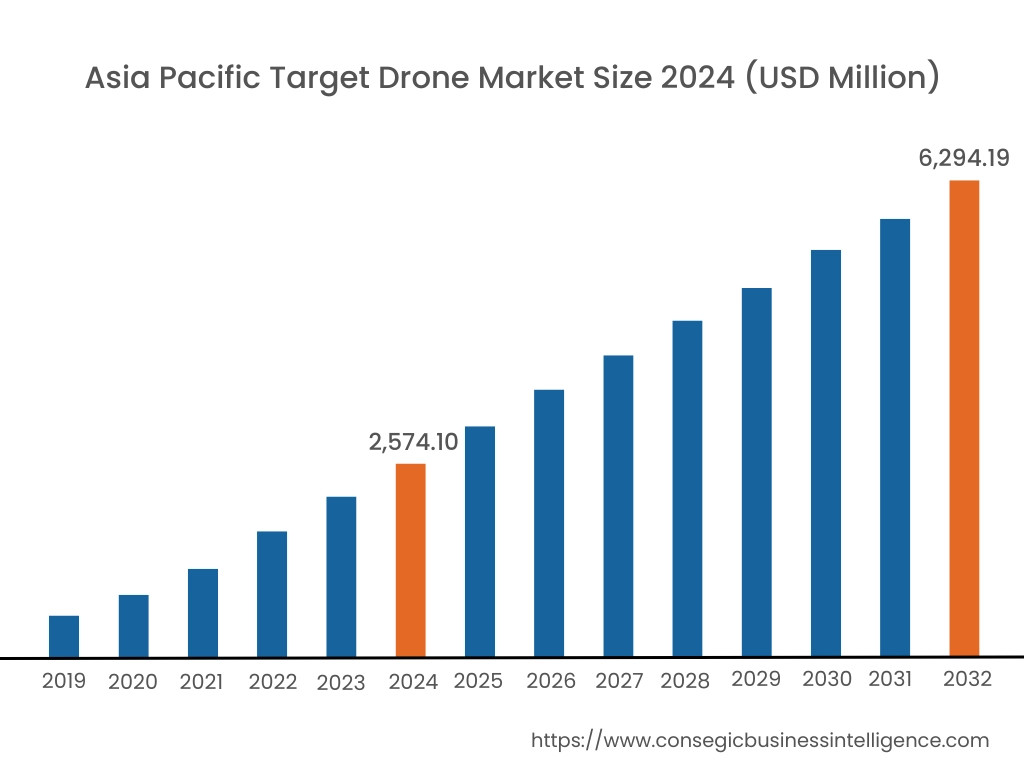
Asia Pacific region was valued at USD 2,574.10 Million in 2024. Moreover, it is projected to grow by USD 2,828.62 Million in 2025 and reach over USD 6,294.19 Million by 2032. Out of this, China accounted for the maximum revenue share of 31.8%. As per the target drone market analysis, the adoption of target UAVs in the Asia-Pacific region is primarily driven by the increasing geopolitical tensions, rising investments in the military & defense sector, and growing need to enhance military preparedness, among others. Additionally, the rising demand for safe and reliable military training solutions is further driving the market in the region.
- For instance, the Government of India allocated approximately USD 70.6 billion to the Ministry of Defense as the part of its Union Budget 2022-23. Thus, the above factors are accelerating the target drone market expansion in the Asia-Pacific region.

North America is estimated to reach over USD 6,699.33 Million by 2032 from a value of USD 2,899.24 Million in 2024 and is projected to grow by USD 3,170.86 Million in 2025. In North America, the growth of the target drone industry is driven by the prevalence of substantial number of defense agencies and the growing military and defense sector, among others. Similarly, the rising government funding for military and defense training is further contributing to the target drone market demand.
- For instance, the U.S. Government allotted a USD 883.7 billion budget for national defence for FY 2024, among which USD 841.4 billion was allocated for the United States Department of Defence. The above factors are expected to boost the target drone market trends in North America during the forecast period.
Meanwhile, according to the regional analysis, factors including the presence of several military & defense organizations along with rising need for safe and reliable training solutions for military personnel are propelling the target drone market demand in Europe. In addition, according to the target drone market analysis, the market demand in Latin America, Middle East, and African regions is projected to rise at a significant rate due to factors such as increasing geopolitical tensions, rising regional conflicts and security challenges, along with growing need for cost-effective military training solutions to enhance combat readiness, among others.
Top Key Players and Market Share Insights:
The global target drone market is highly competitive with major players providing products to the national and international markets. Key players are adopting several strategies in research and development (R&D), product innovation, and end-user launches to hold a strong position in the target drone market. Key players in the target drone industry include-
- Northrop Grumman Corporation (USA)
- QinetiQ Group plc (UK)
- Leonardo S.p.A. (Italy)
- BAE Systems plc (UK)
- Aerotargets International (Australia)
- Airbus SE (Netherlands)
- Lockheed Martin Corporation (USA)
- The Boeing Company (USA)
- Kratos Defense & Security Solutions, Inc. (USA)
- Textron Inc. (USA)
Recent Industry Developments :
Partnerships & Agreements:
- In May 2025, Diehl Defence strengthened its partnership with RV Connex, a defence and security company based in Thailand. RV Connex and Diehl Defence signed a contract for delivering target drones and related services for conducting live firing tests with IRIS-T air-to-air-missile from Diehl Defence.
Target Drone Market Report Insights :
| Report Attributes | Report Details |
| Study Timeline | 2019-2032 |
| Market Size in 2032 | USD 20,670.57 Million |
| CAGR (2025-2032) | 11.4% |
| By Type |
|
| By Target |
|
| By Engine Type |
|
| By Application |
|
| By Region |
|
| Key Players |
|
| North America | U.S. Canada Mexico |
| Europe | U.K. Germany France Spain Italy Russia Benelux Rest of Europe |
| APAC | China South Korea Japan India Australia ASEAN Rest of Asia-Pacific |
| Middle East and Africa | GCC Turkey South Africa Rest of MEA |
| LATAM | Brazil Argentina Chile Rest of LATAM |
| Report Coverage |
|
Key Questions Answered in the Report
What is the size of the Target Drone Market? +
The Target Drone Market size is estimated to reach over USD 20,670.57 Million by 2032 from a value of USD 8,740.32 Million in 2024 and is projected to grow by USD 9,577.48 Million in 2025, growing at a CAGR of 11.4% from 2025 to 2032.
What are the key segments in the Target Drone Market? +
The market is segmented by type (fixed-wing target drones, rotary-wing target drones, hybrid target drones), target (aerial, ground, marine), engine type (internal combustion engine, jet engine, turbojet engine, others), and application (combat training, target acquisition, reconnaissance, others).
Which segment is expected to grow the fastest in the Target Drone Market? +
The hybrid target drones segment is expected to grow at the fastest CAGR during the forecast period, driven by their ability to combine the advantages of fixed-wing and rotary-wing designs for greater maneuverability and operational flexibility.
Who are the major players in the Target Drone Market? +
Major players in the Target Drone Market include Northrop Grumman Corporation (USA), Lockheed Martin Corporation (USA), The Boeing Company (USA), Kratos Defense & Security Solutions, Inc. (USA), Textron Inc. (USA), QinetiQ Group plc (UK), Leonardo S.p.A. (Italy), BAE Systems plc (UK), Airbus SE (Netherlands), and Aerotargets International (Australia).
